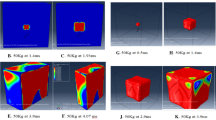Abstract
Accurate estimation of blast loads on structures is essential for reliable predictions of structural response and damage. Current practice in blast effect analysis and design estimates blast loads primarily based on empirical formulae obtained from field blast tests. Due to the limited availability of test data, those empirical formulae are usually applicable to the case that the reflection surface of the structure is big enough so that no wave diffraction around the structure exists. They will overestimate the blast loads on structure columns without infill walls around them, which are very common in the modern buildings, especially for the ground floor columns. For a standalone column, the initial reflected pressure may be quickly relieved at the edge of the column, and the column will be engulfed with the blast wave due to diffraction. Therefore, the interaction between the blast wave and structure is important for such columns. The blast loads on such columns will be different from those obtained in field blasting tests on walls. There is no method in the open literature to estimate blast loads on standalone columns. In the present study, interactions between blast waves and structure columns are simulated using AUTODYN 3D. The influence of the scaled distance of the blast, column stiffness, ratio of the supported mass to the column mass, and column dimension and geometry, on the blast wave–column interaction is investigated. Based on the numerical simulation results, some formulae are proposed to estimate the blast pressure, impulse, and the reflected pressure time history on standalone structure columns.
Similar content being viewed by others
References
AUTODYN: Theory manual. Century Dynamics (2006)
Baker W., Cox P., Westine P., Kulesz J. and Strehlow R. (1983). Explosion Hazards and Evaluation. Elsevier, Amsterdam
Booij, S.M., Absil, L.H.J., Bruinsma, A.J.A., Braat, J.J.M., van Brug, H.: Study of blast wave interactions with structures using a phase-stepped double reference beam holographic interferometer. In: The 18th Congress of the International Commission for Optics (ICO XVIII): Optics for the Next Millennium, pp. 762–763. Society of Photo-Optical Instrumentation Engineers, Bellingham, (1999)
Henrych J. (1979). The dynamics of Explosion and its use. Elsevier, Amsterdam
Kottegoda, N.T., Rosso, R.: Statistics, Probability, and Reliability for Civil and Environmental Engineers. McGraw-Hill, (1997)
Le J. (1999). Numerical simulation of shock (blast) wave interaction with bodies. Commun. Nonlinear Sci. Numer. Simul. 4: 1–7
Luccioni B.M., Ambrosini R.D. and Danesi R.F. (2004). Analysis of building collapse under blast loads. Eng. Struct. 26: 63–71
Luccioni B.M. and Luege M. (2006). Conete pavement slab under blast loads. Int. J. Impact Eng. 32: 1248–1266
Marconi F. (1994). Investigation of the interaction of a blast wave with an internal structure. AIAA J. 32: 1561–1567
Mays G.C. and Smith P.D. (1995). Blast Effects on Buildings. Thomas Telford Serices Ltd, London
Ofengeim D.K. and Drikakis D. (1997). Simulation of blast wave propagation over a cylinder. Shock Waves 7: 305–317
Ohyagi S., Obara T., Nakata F. and Hoshi S. (2000). A numerical simulation of reflection processes of a detonation wave on a wedge. Shock Waves 10: 185–190
Rickman D.D. and Murrell D.W. (2007). Development of an improved methodology for predicting airblast pressure relief on a directly loaded wall. Trans. ASME J. Pressure Vessel Technol. 129: 195–204
Tai C.H., Teng J.T., Lo S.W. and Liu C.W. (2006). A three-dimensional numerical investigation into the interaction of blast waves with bomb shelters. JSME Int. J. Ser. B Fluids Thermal Eng. 48: 820–829
Technical Manual (TM5-1300): To resist the effect of accidental explosions. Department of the Army, Navy and the Air force, Washington, DC (1990)
Thomas G.O. and Williams R.L. (2002). Detonation interaction with wedges and bends. Shock Waves 11: 481–492
Watson S., MacPherson W.N., Barton J.S., Jones J.D.C., Tyas A., Pichugin A.V., Hindle A., Parkes W., Dunare C. and Stevenson T. (2006). Investigation of shock waves in explosive blasts using fibre optic pressure sensors. Measure. Sci. Technol. 17: 1337–1342
Woodson, S.C., Baylot, J.T.: Structural collapse: Quarter-scale model experiments. US Army Corps of Engineers Engineer Research and Development Center (1999)
Woodson, S.C., Baylot, J.T.: Quarter-scale building/column experiments. Adv. Technol. Struct. Eng. 1–6 (2000)
Wu C., Lu Y. and Hao H. (2004). Numerical prediction of blast-induced stress wave from large-scale underground explosion. Int. J. Numer. Anal. Methods Geomech. 28: 93–109
Wu C. and Hao H. (2005). Modelling of simultaneous ground shock and air blast pressure on nearby structures from surface explosions. Int. J. Impacting Eng. 31: 699–717
Author information
Authors and Affiliations
Corresponding author
Additional information
Communicated by C. Needham.
Rights and permissions
About this article
Cite this article
Shi, Y., Hao, H. & Li, ZX. Numerical simulation of blast wave interaction with structure columns. Shock Waves 17, 113–133 (2007). https://doi.org/10.1007/s00193-007-0099-5
Received:
Revised:
Accepted:
Published:
Issue Date:
DOI: https://doi.org/10.1007/s00193-007-0099-5




